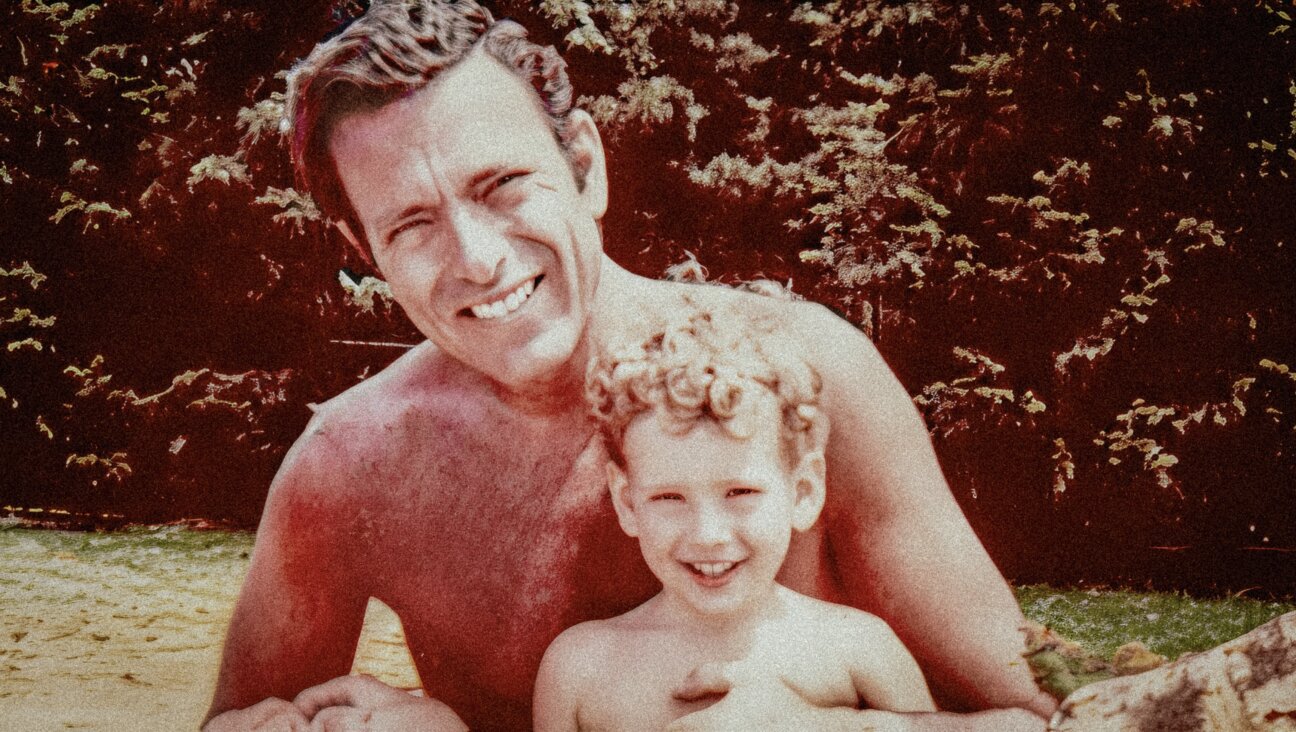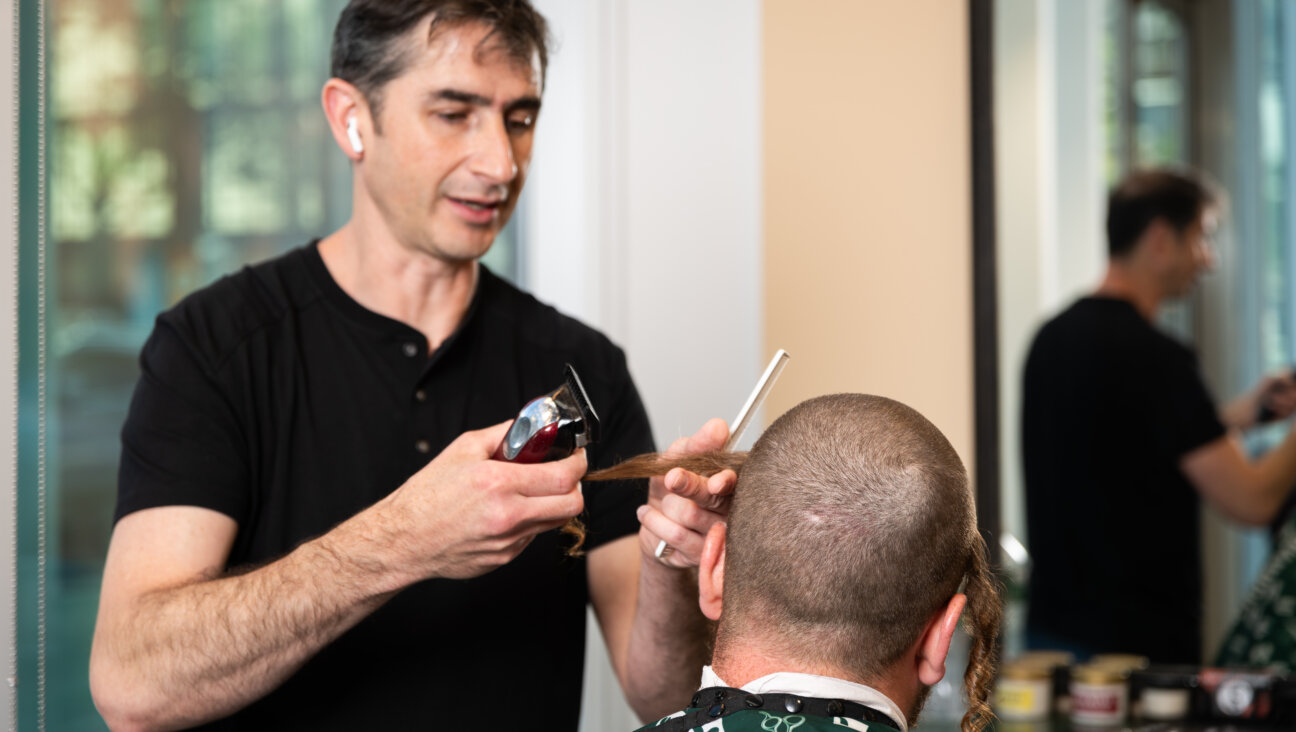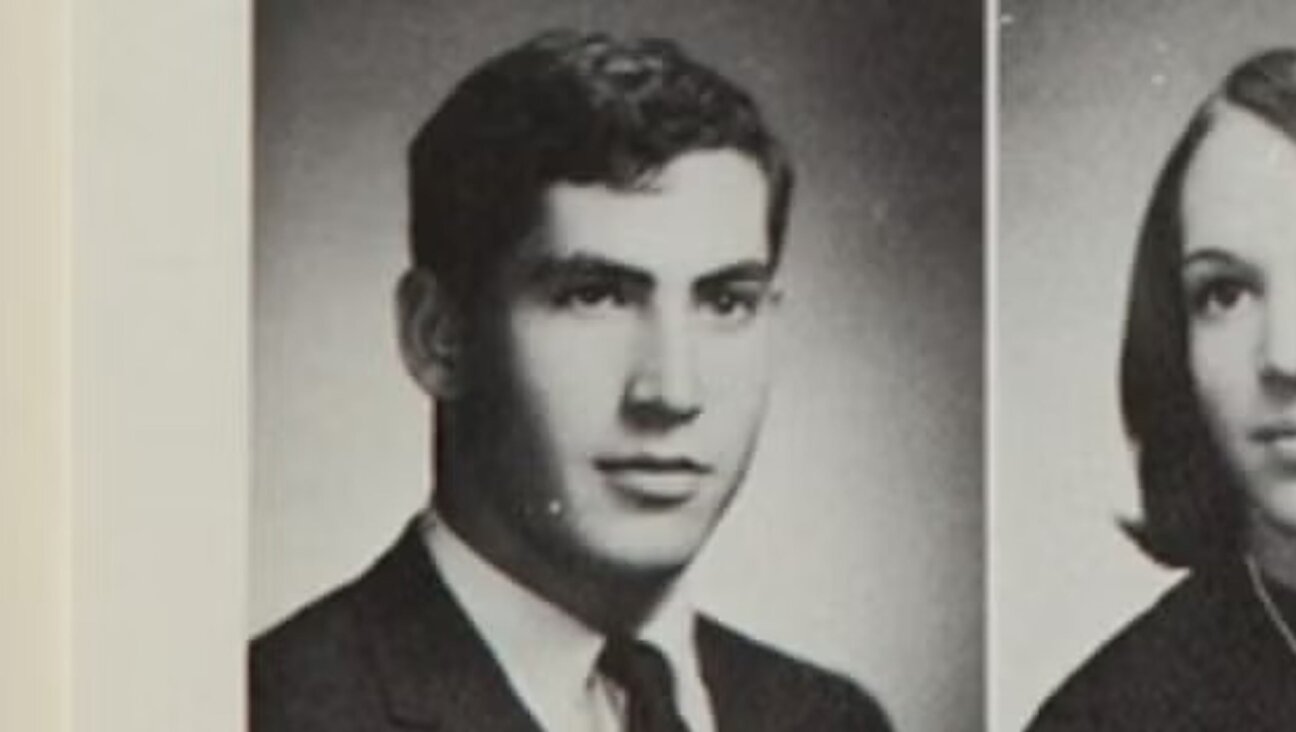In this brilliant exhibit, you can’t look at the art unless you let it look at you

Meow: A still from Barbara Kruger’s “Untitled (No Comment)” Courtesy of Courtesy of the Barbara Kruger, Sprüth Magers, and David Zwirner
At first glance, there’s nothing explicitly Jewish about Barbara Kruger’s work. Yet after viewing “Thinking of You, I Mean Me, I Mean You,” the current retrospective of her five decades of work at the Art Institute of Chicago, on view through January 24, 2022, certain Jewish themes emerge: the value of omnivorous reading, high and low, and of questioning texts, as well as authority.
When you think of Kruger’s work, you might think of her text in Futura Bold font spanning walls in L.A., billboards in Time Square, or the op-ed page of The New York Times. In this retrospective, her largest ever, Kruger brilliantly harnesses the power of the museum space to maximize the effect of her work and to force viewers to re-think their conceptions of her art. Through installing room wraps, multi-screen videos, and updated LED works, Kruger creates immersive environments that cannot take place outside the walls of a museum. She demonstrates why the widespread appropriations of her work on the Internet are not a substitute for experiencing her work; you need to go into the walls of the museum to see it, even though this exhibition spills out to walls and spaces outside of the Art Institute.

At the Art Institute of Chicago: Barbara Kruger’s rendering of exhibition entryway at the Art Institute of Chicago Courtesy of The Art Institute of Chicago
Curator Robyn Farrell calls this an “anti-retrospective” because it is not linear. In the center of the exhibit, rather than the beginning, there is a nod to the small analogue paste-ups from early in Kruger’s career. Influenced by her 11-year career as a designer and picture editor at Conde Nast, these paste-ups mirror the cut and paste technique used at the time in magazine production and are arrayed against one long wall so that one can peer back in time to see the origin of some of her later works.
In works that she calls “replays,” she re-animates some of her well-known still work from the 1980s into moving images by using LED. These replays of previous works, addressing corruption, privacy, justice and how government controls women’s bodies, are still maddeningly relevant today. They bear two dates — the original, and then the more-recent year Kruger in which has re-adapted it. In “Untitled (Your body is a battleground) (1989/2019),” Kruger has taken her still image of a woman’s bifurcated face, and turned it into moving puzzle pieces that then connect into the image of a face; the phrases change provocatively until they end with the original.

“Untitled (Greedy Schmuck)”: A 2017 work by Barbara Kruger Courtesy of Barbara Kruger
Similarly, in “Untitled (I Shop Therefore I Am) (1987/2019),” puzzle pieces connect, slowly then faster as the image forms; when the puzzle is complete, one sees the title phrase, which then morphs into different aphorisms. As each phrase changes, one hears the ka-ching of a cash register. Critiquing our fealty to the institutions of marriage, government and law, the replays “Vow” (1988/2020), “Pledge,” (1988/2020), “Will,” (1988/2020) each occupy their own wall in a room, and the words of the marriage vows, pledge of allegiance, and last will and testament morph to the loud clicking sound of a typewriter, as if we are seeing these documents in the very process of being created and revised. Kruger uses timed video hookups so that the screens play off each other; the use of sound enhances the feeling of sensory immersion.
As is the case with much of the rest of the exhibit, Kruger’s room wraps are immersive environments that need to be experienced in situ: enlarged text wraps the floor and walls, enveloping the viewer. Standing in a Kruger room wrap, one feels like Alice in Wonderland; indeed, the quote “You are here, looking through the looking glass, darkly,” appears in the center of a wall in Untitled (Forever), 2017.

“Untitled (Forever)” A 2017 work by Barbara Kruger. By Timo Ohler and courtesy of Sprüth Magers.
In other work exhibited here, Kruger addresses social media and our addiction to selfies. In “Untitled/(Selfie) (2020), there’s a warning above the door to a room: “Please do not enter unless you consent to be pictured while picturing. A phone/camera is needed for entry. Thanks.” It’s not stated exactly what Kruger will do with one’s image. One enters the room feeling a slight frisson of fear, wondering, will taking a selfie be worth the trade-off here? Kruger is critiquing our constant need to mediate experience through taking photos of ourselves.
One finds out later that this room wrap is being filmed and the image is being projected onto two tiny video screens, one by the Modern Wing, and one by the Michigan Avenue exit. While the viewer thought she was the one taking the selfie, she was unknowingly being watched. The spectator has become the surveilled.

The Globe Shrinks: Installation view at the Barbara Kruger exhibit in Chicago. Courtesy of Barbara Kruger and Sprüth Magers
Similarly, when viewers enter a dark room to watch a video, “The Globe Shrinks,” (2010) there’s no one spot that allows one to see all three walls of screens; viewers have to move around. The design of the room evokes a sensation akin to the feeling of seeing your house on Google Street View and realizing your home is always being watched. As usual, Kruger undermines binaries – here between voyeur and exhibitionist, watcher and the one being watched.
After viewing all the flashy LED screens upstairs, the relative quiet exhibit of five videos on a small analog TV screen in a gallery of Roman sculptures speaks loudly. These videos, “Public Service Announcements” (1996), made during Kruger’s artist residency at the University of Ohio, debuted on Columbus Public Television; shot originally on 16 mm film, then transferred to video in black and white, each features a different vignette. In one, a heart beats throughout and an elderly man looks at the viewer and implores, “Just don’t leave me alone. Okay? Just don’t leave me alone.” Then, these words flash — “Empathy can change the world.” Another video, this one about domestic violence, concludes with “Don’t be a Monster. Keep your hands to yourself.” Each of the videos ends with the tagline, “It’s cool to be kind. Live and let live.”

**”Untitled (Truth)”: A digital image from Barbara Kruger’s 2013 work. Courtesy of Barbara Kruger
These videos may remind the viewer of the story of how when Hillel is asked by man to teach him the entire Torah while he stands on one foot, Hillel answers him, “That which is hateful to you, do not do to your neighbor. That is the whole Torah, all the rest is commentary.”
Indeed, the very title of Kruger’s exhibition, “This is About you. I Mean Me. I Mean You” emphasizes how we each resist a pull away from our natural inclination to focus on ourselves, to take that selfie. As Kruger said in 2012, “I try to make work about how we are to one another.” Here Kruger begs us to pull ourselves away from our narcissism towards a focus on “You,” the other. The entire retrospective then, indeed, all her work, through its various mediums, replays and iterations is a PSA from Kruger to the world: Question everything. Don’t be cruel. Have empathy. All the rest is commentary.



















